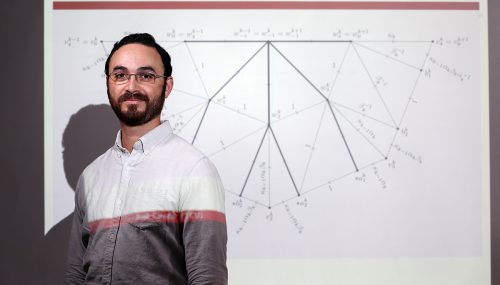Professor Studies Operator Algebras to Better Understand Quantum Mechanics
Mathematics professor shines a light into the unknown in search of scientific connections.
Professor Studies Operator Algebras to Better Understand Quantum Mechanics
Mathematics professor shines a light into the unknown in search of scientific connections.
In theory, José Carrión’s research in operator algebras could improve the understanding of quantum mechanics, which could one day inspire new dimension-shifting technologies.
However, any such invention would occur far in the future and, really, is outside Carrión’s area of expertise. “I’m not an expert in quantum mechanics,” said the assistant professor of mathematics. “I can’t even claim any deep knowledge into it.”
But Carrión knows the basics: Werner Heisenberg’s 1927 proposition of the uncertainty principle redefined physical reality as an interplay between matter and energy whose manifestation is dependent upon the observer.
Since then, physicists have developed technology based on quantum principles, including encryption techniques used across the internet.

José Carrión’s research focuses on operator algebras that could improve understanding of quantum mechanics. Photo by Carolyn Cruz
José Carrión’s research focuses on operator algebras that could improve understanding of quantum mechanics. Photo by Carolyn Cruz[/caption]
Mathematicians have been building numerical systems, including operator algebras, that might one day explain why a butterfly beating its wings in Texas could cause a tsunami in the Indian Ocean.
But Carrión is more concerned with a “tiny corner of operator algebras” than with the butterfly effect or quantum computing. His specialty studies movements in spaces, but not the sort that can be plotted on 3-D grids. Quantum spaces are infinite, extending in every dimension and direction, and the moving “objects” are clouds of probable locations rather than tangible points.
Working with equations when infinity is a variable is a mind-boggling task, but algebra has been used to solve mathematical mysteries since ancient Babylon. The method is simple: Use what is known to figure out what isn’t, which is what Carrión does.
Some of the operator algebras Carrión researches employ nuclearity, or “modeling this infinite-dimensional object using finite-dimensional data.” The professor’s current project aims to link this “internal modeling” process with an outward-modeling technique known as quasidiagonality. He describes the latter as this: “Shine a light through [the infinite-dimensional models] and look at the shadow. The kinds of lights that you’re shining through this give you shadows that you can understand, finite-dimensional things.”
By examining the models side by side, Carrión searches for symmetry, a principle also at the heart of quantum mechanics, where relationships exist in the physical world without obvious causality. If a heretofore-hidden link emerges, luck might play a part, he said. “The interconnectedness between all these different theories isn’t something that you start out planning for. It just happens.”
For instance, the professor said that recent discoveries have linked computer science with operator algebras. Quantum superposition, which is like saying a particle can be in two places at once, could revolutionize computing with faster speeds, stronger encryption and denser data-storage possibilities.
For now, Carrión said he prefers sitting in his chair in ordinary reality and conducting math research, a process that involves reading journals, proving the occasional theorem and allowing time and space for old-fashioned thinking.
“You kind of have to carry these ideas around,” he said. “You have to live with them and dream about them and constantly be thinking about them. Have them present all the time, and once in a while, you will have a light bulb go off.”

Your comments are welcome
Comments
Related reading:
Features
The Magnificent Seven
TCU’s seven active Piper Professors share the challenges and triumphs of educating Horned Frogs over the decades.
Features
Computer Science Students Design Apps in Class
Capstone projects give teams chance to use software design skills to help clients improve services.
Research + Discovery
Carson Huey-You is TCU’s Youngest Graduate
Physics prodigy tackles ‘the Big Kahuna’ in research.